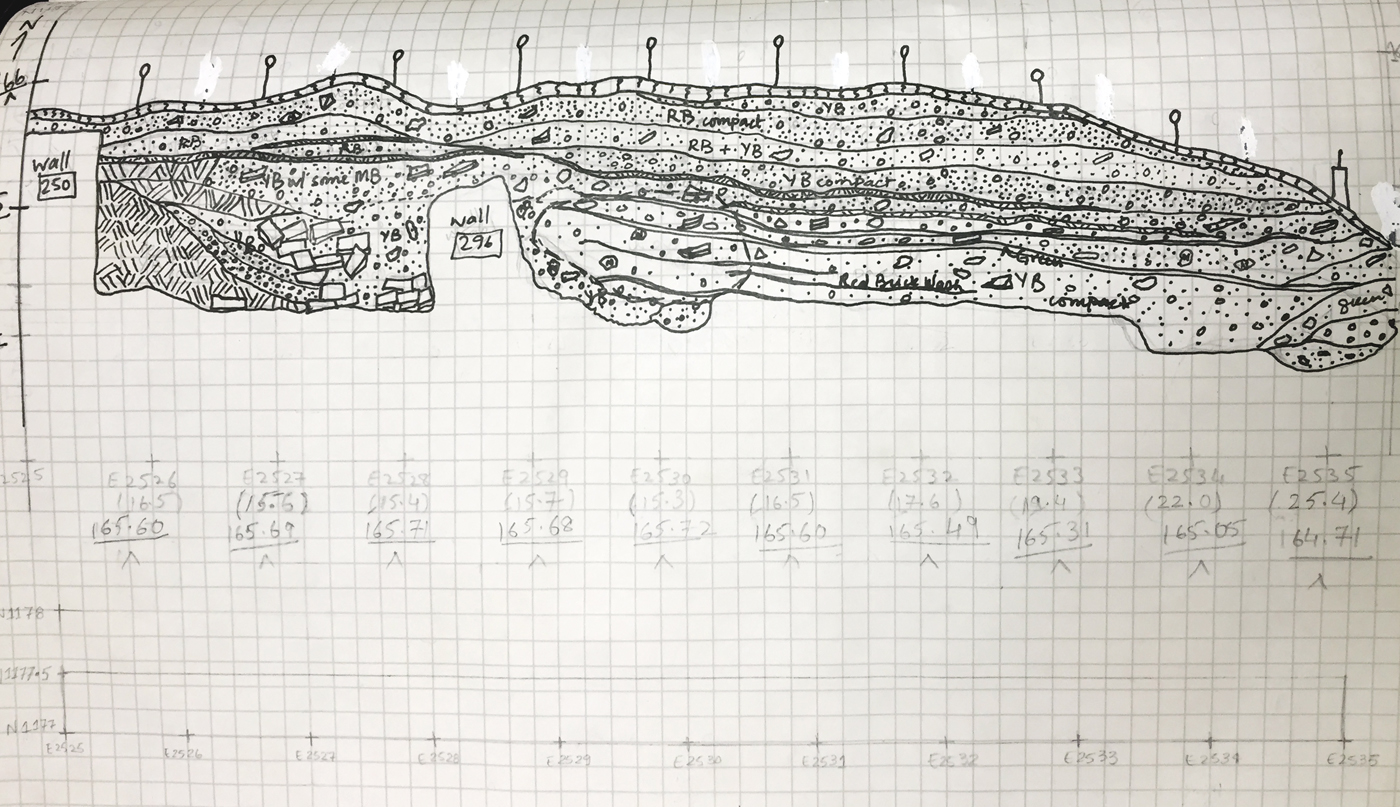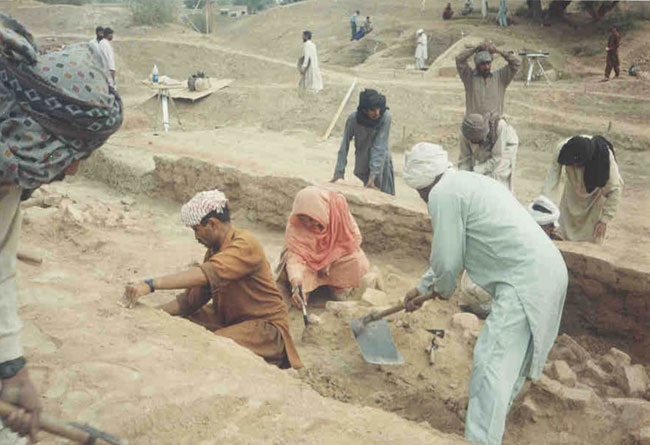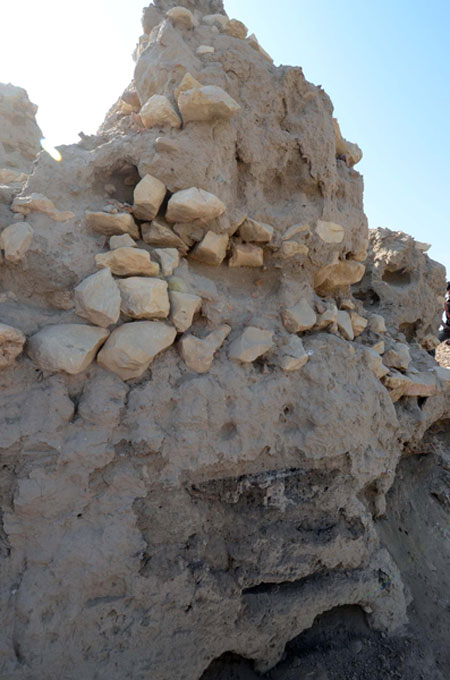— Theorizing Deposition: Transitional Stratigraphy, Disruptive Layers, and the Future

If you grow into your own sense of self and body knowing that both space and time are normatively known to be under your control, then certainly all space, all time, and thus all history, archaeology, and heritage is your body’s or no body’s.
If we have learned anything from Bill and Ted’s Excellent Adventure (1989), it is that even in postured idiocy, the heteronormative white male protagonist might have a chance to control the past. It is that body which seems to be allowed to move through time, controlling and developing technologies that create those pathways. And it is also only those bodies that maintain the privilege to bungle it.
In order to claim that white heteronormative male space, I returned to my first encounter with field practice, that space of naive wonder and hypersensitive care for all things ancient. I found myself in a materially enclosed space that allowed me to move in the betweenness of time, transition, disruption, and now. There is something about the materiality of an enclosed space that allows the popular normative imagination to transport that space into the future. And it is only certain coming-of-age stories that are privileged enough to allow an imagining of a past, a construction of history, and a trip back to the future to be integral in growing and learning about oneself in relation to the world. That allowance provides a very neat understanding for how debates around the universality of global heritage unfold.
Listen to the mudbrick. It will tell you where it begins and where it ends. Be wary of falling into the trap of the wash. The wash sounds like mudbrick but it is not a wall. It is only the wash of a wall. You must learn how to recognize the walls.
—Chacha Nawaz (Harappa, 1997)
From the moment I held a trowel in my hand, I was taught how to feel. I was taught how to angle my wrist to scrape, feeling the sound of a floor, fill, or wall alignment each time my trowel touched the ground. My trowel was my prosthetic hand and through that I was introduced to an alternative universe of relational tactility. My teacher through all of this was Chacha Nawaz, one of the senior staff in the trenches, and one of the best excavators at Harappa in Pakistan.

I had dug myself into and in between a large wall—or what we initially thought was a large wall. I sat in mudbrick and its wash, other people’s garbage, and learned to touch, breathe, and scrape it. There is something lovely about the sloping nature of the deposits of mudbrick that slowly accumulate at the foot of the wall. There is elegance to the way mudbrick weathers its life. Wrinkles and crevices emerge as parts of it crumble to the ground, fly away with a gust of wind, or slowly slope down as wash. I can remember when I first encountered this wall. I did not know how to communicate with this wall, or what it meant to be in between this wall. Or what a wall even meant.
And yet, there I was, excavating a feature that we called a wall. It controlled the movements of people. It controlled a landscape. It controlled my excavation. This wall grew with time. Rather than making a solid wall throughout its width, an in-betweenness developed as a desire to widen the wall began to show. The trash that was tossed over the wall, the sloped debris, the excruciating secondary nature of this deposit, the mudbricks, the mudwash, and the spaces that existed on the margins were all encapsulated by this new wall. And our hands, our trowels, our bodies, our breath, mingled with the exposure and animacy of these forms of ancient control. The secondary deposit held together a primary feature called a perimeter wall on the east side of Mound E.
Shadowing the perimeter wall is what has been termed a curtain wall. I have never been quite clear about what a curtain wall is. Is it a wall that covers another wall? A wall that follows another wall or that shades another wall? I am not entirely certain what secrets the second wall was hiding, but I do know that time, in between those two walls, did not exist in a discrete manner, depositionally speaking (if one can indeed speak that way). I remember asking how I was supposed to note this disturbance—this mixed context, this mess—in my notebook, particularly because all of the mess was not as explicit in the section. What was my scientific explanation for the material in between a wall that was hiding another wall? And what did this sort of construction suggest about the political structuring, the philosophy, and the relationships reflected in the urban plan?
I was taught that in order to scientifically and ethically reconstruct the past, we utilize the information that we have from excavation and bring it all together to make the most reasonable and plausible meaning. And so our scientific sense-making about the political philosophy of the past, embedded in an urban plan, can only be to some extent improvisational.
Insofar as Western political philosophy is indebted to the Enlightenment, it is also epistemically entangled with the scientific revolution of the seventeenth and eighteenth centuries in Europe. The tension in the relationship between science, political philosophy, and the improvisational nature of each comes into high relief in projections of both the past and the future. The possibilities of a past or the past are full of curtain walls, and the possibilities of a future or the future are in our particular contemporary moment both apocalyptic and consumed by just that improvisational nature. At the same time, within apocalyptic spaces, the possibility of new futures emerges—futures anchored in change. If that change has to be apocalyptic, so be it. It is in the performance of that projected future that one might begin to think about the speculative fiction of time. The mobility of time becomes the project of modernity, and in the mobilization of time, of normative modernity. Does recognizing improvisation then disrupt Western normative modernity?
But this was not the original wall. This was a wall built upon a wall. Not in period 1 (3300–2800 BCE), nor really in period 2 (2800–2600 BCE). Rather, this wall is built upon the wall dated to the beginning of the Harappan phase, period 3A (2600–2450 BCE). This second wall was constructed during period 3B (2450–2200 BCE). It was built upon the previous mudbrick wall, which had eroded, and in fact, that earlier wall had been modified by leveling in some areas, or by the construction of a foundation trench. We can date the repairs to the Mound E perimeter wall to period 3C (2200–1900 BCE).1See → In a broader chronological sense, this wall was not constructed in the Early Harappan period 1 or 2, but rather in what is referred to as the Mature Harappan period of the site.
In the South Asian landscape of the third millennium BCE, distinctions have been created between the Early Harappan period and the Mature Harappan period based on settlement patterns, evidence of public architecture, degrees of craft specialization, the presence/absence of a writing system, increased trade, and regional styles of material culture. Distinctions within these criteria have been taken to signify ethnicities, versus the overall homogenization and standardization of cultural materials over a larger regional Harappan veneer. The two main periods are separated by what archaeologists call transitional phases, indicated by disruption, change, renewal, and abandonment. Disruption manifests itself in the form of burnt stratigraphic layers and deposition, potential indicators of earthquakes or abandonment. The sites of Balakot, Kot Diji, Gumla, Kalibangan, Amri, Nausharo, and some sites in the Sindh/Cholistan area provide evidence of disruption in transition.

In the excavation reports of Kot Diji, Professor F. A. Khan wrote:
A thick deposit of burned and charred material, on top of layer (4), spreading over the entire site, completely sealed the lower levels (Kot Diji) from the upper ones (Mature Harappans). This prominent and clearly marked burnt layer strongly suggests that the last occupation level of the early settlers (that is the Kot Diji) was violently disturbed, and probably totally burnt and destroyed.2 F. A. Khan, “Excavations at Kot Diji,” Pakistan Archaeology 2 (1965): 11–85.
A layer violently disturbed, and probably totally burnt and destroyed: a clearing of a slate to start afresh. The outcome of violence seems part of a creative impulse. Because you want to create something new, you have to destroy and disrupt what is already there. It almost induces hope, insofar as one might hope for change. Archaeologists have since reinterpreted this ashy deposit as a disruption to strata in an otherwise continuous occupation.3 Jonathan Mark Kenoyer, “Changing Perspectives of the Indus Civilization: New Discoveries and Challenges,” Purattva 41 (2011): 1–18.
But disruption causes time to slip and sounds dissonant under our trowel. It forces us to improvise and create a different set of skills to cope with the desire and intimacy with and within walls, burnt spaces, and transitional stratigraphy. All of the evocative, ambient, bundled things relate to each other as assemblages. While excavating these in-between spaces, in particular the spaces between walls, there are multiple time periods that are simultaneously indexed and extractable—it is almost never the case that an archaeological event represents a static and singular experience. It is almost always a slipping in and out of a mixed context.
But every layer represents many points in time—from the point it was constructed all the way to the future. Every layer deposited upon it will lay its own weight and heft, which will determine the density of the deposit, and if the soil does not take action, the wind and humidity will alter and transform the ways in which the site maintains itself.
In 1993, when Octavia Butler first published Parable of the Sower, the first book in what had been intended to be a science fiction trilogy, she divined a future moment (2024) in which a young black woman would bring salvation to communities in a postapocalyptic moment. Our protagonist, Lauren Olamina, at fifteen, could feel others’ pain. She had hyper-empathy syndrome due to certain drugs her birth mother had been taking. Reversing the stigma of the diagnosis, hyper-empathy becomes the catalyst through which she leads people to believe in hope and change. Butler’s book begins with these words, framing a religion based on nonfixity, nonplaceness, malleability, and empathy for everything:
Consider: Whether you're a human being, an insect, a microbe, or a stone, this verse is true.
All that you touch
You Change.
All that you Change
Changes you.
The only lasting truth
Is Change.God is Change.4Octavia E. Butler, Parable of the Sower (New York: Seven Stories Press, 1996 [1993]), 1.
It was as if new materialisms, critical feminist theory, and science fiction found a common birthplace. It is only when we start in the future that we allow for radical alterities to exist, even if only by structuring our political philosophies and culture of hope and change.
I often find myself looking closely at mudbrick walls. Even if I am unable to physically stand by them, I spend hours obsessively staring at images of them; sometimes I even use my fingertips to enlarge images of them. I think of when I might (in the past and future) smell it, touch it, and feel the texture against my fingertips and my trowel.
The promiscuous nature of mudbrick is that it will never appear fixed. Mudbrick enters into the early morning light wearing its heart on its sleeve: everything is visible. It is savvy and street smart in the brilliance of the afternoon sun, eradicating differences in soil, and for that time there is a visual cosmic unity. The evening brings a relaxed nuance, when moonlight over the mudbrick walls line these ancient cities in silver. Their seductive and ever-changing character renders invisible the systems of control that walls are presumed to impose. And the hollowness of that control is finally felt in the disruptions between the walls.
×
Dedicated to Chacha Nawaz


